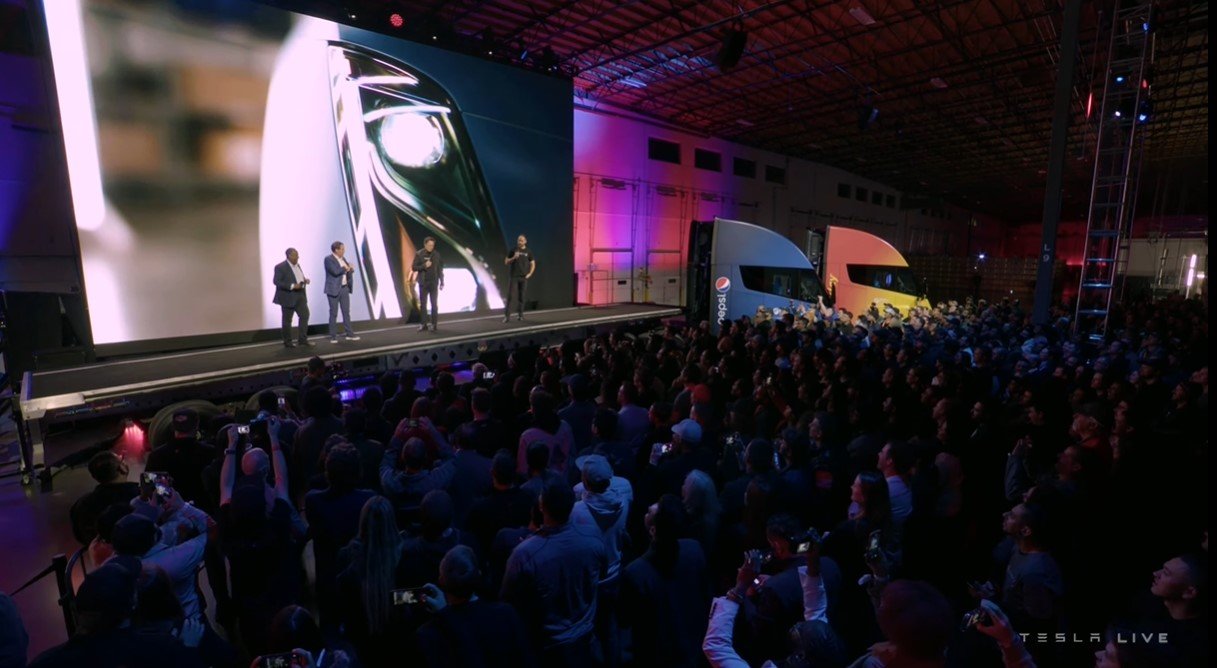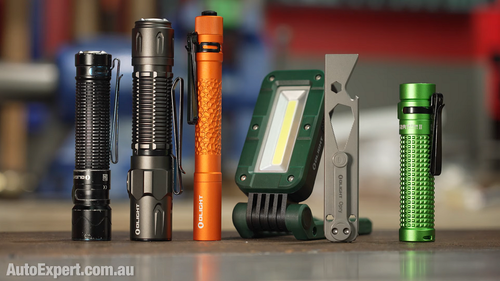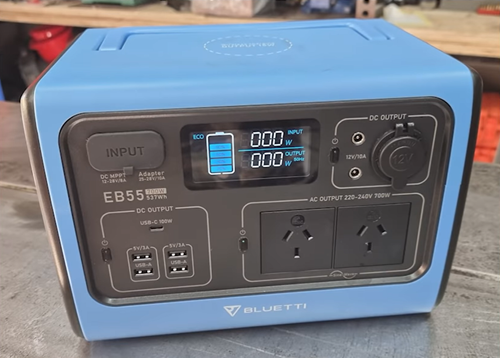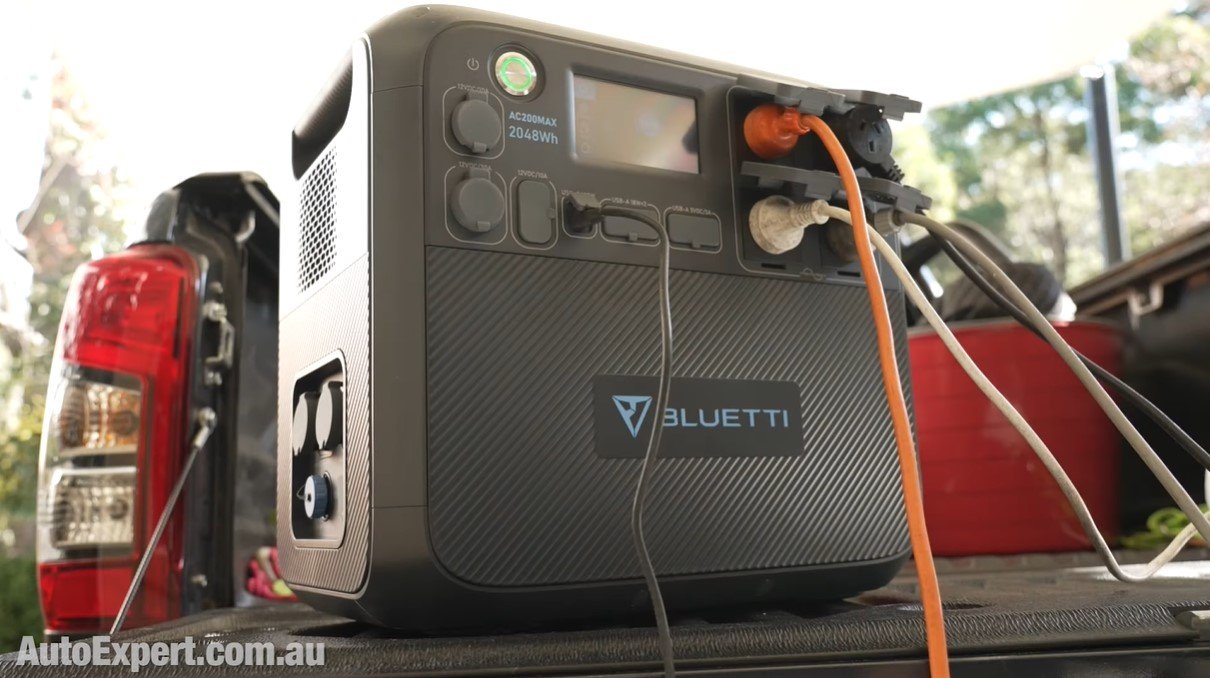Why Tesla's Semi truck might be the worst big rig ever...
Late, ugly and shrouded in unknowns. Little is official about the Tesla Semi truck, but Electric Jesus won’t let the facts get in the way of a good publicity stunt. Here’s why the numbers on Elon Musk’s overhyped long-haul laughing stock don’t add up…
The Techno King of Tesla himself, Elon Musk, took a rare break from eviscerating Twitter recently, to single-handedly orchestrate the delivery of a box of crisps all the way out in Nevada.
He did it with a Tesla Semi truck - only three years late.
Better late than never? Not really - as you’ll soon discover… Image: Tesla/YouTube.
Here’s what one of the Messiah’s worshipers had to say to me after the ‘delivery’ - AKA publicity stunt - performed by Electric Jesus himself.
I expect John the Bogan will go quiet on the subject of the Semi rather than admit that he was dead wrong.
He's now been run over by the reality of the Semi with a 500 mile range and 36 ton payload.
Firstly, it's not 36 tonnes of payload, Roger, it's 36.7 tonnes of overall fully-laden truck - it's the gross vehicle mass. See, tractor trailers (as they’re called in America), which we would call a semi-trailer here in Australia, as fairly confusing as it is.
Over there in the States, 36.7 tonnes is how they roll maxed-out, and as we'll get to below, you don't get paid for delivering the whole truck and trailer. You only get paid for the payload.
The rest of the truck, your prime mover, the trailer, the hydraulic crane mounted behind the cab, the three-wheel lift truck, the interlocking gates, the pallets - none of that stuff is what you get paid for. It’s all along for the ride (and further consumes fuel, remember).
You only get paid for delivering the load - every single kilogram of it. In this regard, the Tesla Semi is an epic failure.
Here’s all you need to see of the cult’s delivery event: (Images: Tesla/YouTube)
Electric Jesus himself, also know by his disciples as Elon Musk, said things about the Semi (the prime mover, not the thing he was nursing…down there). He said:
…the most badass rig on the road…
He loves sounding in touch, doesn't he? And yet, as he tries so very hard to, continues failing so spectacularly, every time, seemingly.
On the Tesla website, the company also says of the Semi it offers:
…badass performance…
They really are a bit ass-fixated aren't they.
Truck operators don't care about badass performance. They care about the payload, the cost of operation and the time it takes to get from A to B. Ask any one of these drivers to wait an hour to fill up with diesel, see how that goes:
This is one of the most economically, rationally driven industries on the planet. Everybody is fiercely competitive and even go as far as discounting themselves out of business, from time to time.
The facts appear to be that the Tesla Semi, which is three years late (well done, Mr. Consistency), it did 500 miles recently, operating at a GVM maxed out for a miracle at 36.7 tonnes. That's the fact.
But Tesla did not actually say something important. They very cleverly omitted a specific detail and of course, all the media in America and elsewhere seemingly, are pretty much too dogshit dumb to point this out. Any idea what critical info they left out?
They did not openly tell us what the empty weight of the truck was - and that's kind of critical.
My AutoExpert AFFORDABLE ROADSIDE ASSISTANCE PACKAGE
If you’re sick of paying through the neck for roadside assistance I’ve teamed up with 24/7 to offer AutoExpert readers nationwide roadside assistance from just $69 annually, plus there’s NO JOINING FEE
Full details here >>
AutoExpert DISCOUNT OLIGHT TORCHES
These flashlights are awesome. I carry the Olight Warrior Mini 2 every day - it’s tiny, robust, and super useful in the field or in the workshop. Olight is a terrific supporter of AutoExpert.
Use the code AEJC to get a 12% discount >>
Generators suck! Go off-grid with AutoExpert BLUETTI PORTABLE POWER STATIONS
Need mobile, reliable power? If you’re camping, boating, caravanning or building a dirty big shed in the back paddock, and you need to run a refrigerator, lights, air conditioner, cooking, and/or a bunch of tools - Bluetti has a clean, tidy, robust solution…
Get your AutoExpert free shipping discount here: https://bit.ly/3n62heK
WHAT’S NOT BEING SAID
It’s time to reverse engineer the Tesla Semi, so let's get into the facts here because I'm big on the facts. (Click here if you need to brush up on Understanding Batteries: Watt-hours, Amp-hours, power, energy and more >>)
What they actually did was deliver the first Semi to PepsiCo, which loaded it up with a payload from its subsidiary Frito-Lay and they drove it to the Tesla launch event in Nevada. The advertising opportunity alone must’ve been worth if for the second most popular soft drink brand.
Four Musk-ateers spoke about nothing of import and told us almost nothing about the truck that mattered. Image: Tesla/YouTube.
This was a 500 mile journey across California, or 804 kilometres in the metric world.
Tesla says the Semi consumed two kilowatt-hours per mile on this landmark deposit/delivery. What does that mean? It tells us how big the battery was.
Tesla actually says:
less than two kilowatt hours per mile…
But that's like saying ‘I'm less than 100 kilos’ when you're 99.7 - so let's assume it's two kilowatt-hours per mile. That's 1000 kilowatt-hours of energy storage in the battery.
Assuming it's two kilowatt-hours per mile, that's 1000 kilowatt-hours of energy storage in the battery. You could also think of that as one megawatt-hour of energy. That's a freaking big battery.
This Tesla Semi battery is roughly four times bigger than the ridiculous, heavy battery in the electric Hummer. When you look at a more conventional car like a Kia EV6 or a Hyundai Ioniq 5, their battery packs are 77.4 kilowatt hours - so the Semi’s battery is about 12 times bigger than that. We’re talking about a gargantuan size battery here, and the size of the battery really does matter. Why?
Well, lithium-ion is a game changer for batteries and this is why we saw an explosion in the effectiveness of power tools and portable electronic devices like smartphones, computers etc. because the energy density is so good in those applications.
Unfortunately, in automotive applications you have to build other features into the lithium-ion battery architecture, such as a big strong metal box to contain it all because it might crash one day. It also has to hold a cooling system so that you don't invoke a catastrophic thermal runaway event while you recharge it. Thermal runaways are bad, FYI >>
We're really talking about 180 to 200 kilowatt-hours per tonne for the battery and here’s why this matters.
Tesla Semi ‘recharges’ its 1 megaWatt battery, allegedly. Image: Tesla/YouTube.
Using 180-200kWh means the battery weight is going to be either 5 or 5.6 metric tonnes. It's 5 metric tonnes at 200kWh and it's 5.6 at 180kWh per tonne. It must be in that ballpark because that's where the technology is.
Despite what the Messiah says, he does not have access to any bespoke miraculous new technology. He's working with the same periodic table of elements as the rest of humanity and he’s subject to all of the same constraints about cooling, packaging, optimising the chemistry for different features such as longevity and stability.
What does 5.6 tonnes of battery look like? It’s two and a half Toyota Hiluxes on a truck, just to move it. It’s actually near enough three Hiluxes.
Obviously, if you put an extra three Hiluxes on the back of your truck, that's 5.6 tonnes of mass that you cannot carry as payload. Exactly how much is this kind of added lard going to cost your typical trucking operation? And how will this deficit translate to the Australian trucking and freight industries? Let’s find out…
HOW AUSTRALIA TRUCKS
In Australia, our trucks are similar but slightly bigger. This is principally because in America a semi-trailer tractor trailer is an 18-wheeler. Here in Australia, we do 22 wheels, so we get an extra axle, which means we can carry more load because the load per axle is fixed, essentially.
Australian trucks are:
42.5 tonnes GVM for a semi-trailer
About 26 tonnes (approximately)
16 tonnes for the truck
Australian diesel trucks (the industry of which is long overdue for an emissions regulation overhaul) do things differently. Configured like below, they tend to be about 15 per cent heavier than in America because of that extra axle and the fact that they can just carry more. We're talking about single trailer here, not B-double.
Standard: 22-wheels, six axles; Kenworth Australia gives owner-drivers a spec sheet with every aspect of the K220 >> Image: Kenworth Aus
In America, trucks are:
36.7 tonnes GVM
About 23 tonnes for the payload
the truck at about 14 tonnes in this case.
Let's think about the Tesla Semi with its 5.6 tonnes of additional Hiluxes in the form of a battery, just jammed in there somewhere and conveniently not mentioned by the Messiah.
For an internal combustion American truck, the gross vehicle mass of both it and the Tesla Semi is 36.7 tonnes. Payload is 23 tonnes for the combustion truck, or 18 tonnes for the Tesla Semi - about five tonnes less, because it's a zero-sum game.
In the case of the combustion truck’s kerb weight, it’s about 14 tonnes and that means in the case of the Tesla Semi, it must weigh about 19 tonnes.
But before you think ‘that's not so bad’, consider this. Payload for the combustion truck is 62 per cent of the total mass, so that's quite efficient when you're moving the whole package from A to B but only getting paid for the payload. That means you're getting paid for 62 percent of this enormous, heavy, thirsty beast that you're moving around.
Payload is king. That’s probably why it’s called ‘payload’. It pays.
But for the Tesla Semi, it’s only 49 per cent of the total overall vehicle weight which is payload. Even worse for the Tesla Semi: do not be fooled into thinking that this is a reduction of ‘only 13 per cent’, because in terms of the proportional reduction, it's actually 21 per cent worse in terms of its payload efficiency.
How is this such a success?
A very heavy, inefficient beast at that. Guess that’s kinda accurate. Image: Tesla.com
Lastly, Tesla says:
…you can recoup 70 of the range in just 30 minutes using a Semi charger…(supplying) one megawatt
There’s one major problem with that.
Recharging 70 per cent of the 500 mile range is 350 miles, because seven fives are 35, and add the zeros, at two kilowatt-hours per mile. What does that actually mean? It means that if the battery is 1000 kilowatt-hours and you're putting in one megawatt of charge in just half an hour, that's 500 kilowatt-hours.
How can it possibly be 350kWh? That’s not 70 per cent of the charge.
The numbers literally do not add up.
Something is either wrong with the claim, because the numbers fundamentally don’t agree and not by a small margin. It’s a substantial error - one that a so-called engineer like Electric Jesus couldn’t miss.
The question is, what is he not telling the public?
There’s even more analysis in the full video report which will detail exactly how much owning and operating a Tesla Semi will cost your typical Australian or American trucking business.
It’s even more laughable that Elon Musk thinks he’s going to “revolutionise the road” with this thing when he can’t even do basic maths.
































xxxx